Yuki's Flying Card Models
http://www2u.biglobe.ne.jp/~poseidon/
Instruction - BAE Systems Hawk T.1 -
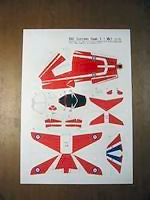 To build flying models, it is recommended to use index or card weight paper (approximately 100 - 130 kg), which is much heavier than the normal paper you usually print with. When you use heavier paper, the planes will be more rigid and the wings will not flop around as much. Be careful before feeding heavy paper through your printer. Some printers do not support the use of heaby card stock paper. You'll want to check your printer manual before purchasing this type of paper.
To build flying models, it is recommended to use index or card weight paper (approximately 100 - 130 kg), which is much heavier than the normal paper you usually print with. When you use heavier paper, the planes will be more rigid and the wings will not flop around as much. Be careful before feeding heavy paper through your printer. Some printers do not support the use of heaby card stock paper. You'll want to check your printer manual before purchasing this type of paper.
STEP 1: Wing
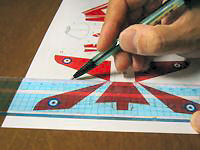 Remember to score all dashed lines before beginning to cut and assemble your model.
Remember to score all dashed lines before beginning to cut and assemble your model.
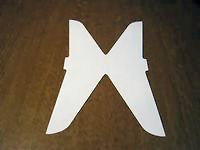 Cut out part #10 and rotate it as shown with the printed side down.
Cut out part #10 and rotate it as shown with the printed side down.
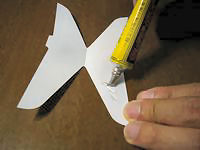 Coat one side surface with the glue. Place the wing on a flat surface, fold down and smooth out glue. Weight down so that the glued wing dires flat.
Coat one side surface with the glue. Place the wing on a flat surface, fold down and smooth out glue. Weight down so that the glued wing dires flat.
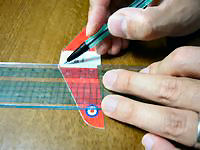 When glue is thoroughly dry, score all dashed lines.
When glue is thoroughly dry, score all dashed lines.
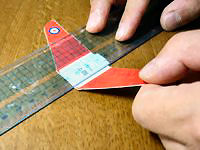 Bend up along the scored dashed line for dihedral.
Bend up along the scored dashed line for dihedral.
STEP 2: Horizontal Stabilizer
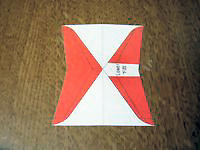 Cut out part #9 as shown in the right picture.
Cut out part #9 as shown in the right picture.
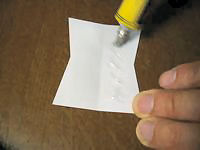 Rotate the part as shown with the printed side down and coat one side surface with the glue.
Rotate the part as shown with the printed side down and coat one side surface with the glue.
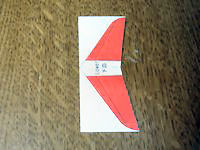 Place the wing on a flat surface, fold down and smooth out glue. Weight down so that the glued horizontal stabilizer dires flat.
Place the wing on a flat surface, fold down and smooth out glue. Weight down so that the glued horizontal stabilizer dires flat.
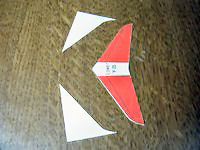 When glue is thoroughly dry, cut out white space as shown in the right picture.
When glue is thoroughly dry, cut out white space as shown in the right picture.
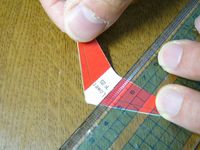 Score all dashed lines and bend up along the scored dashed line for anhedral.
Score all dashed lines and bend up along the scored dashed line for anhedral.
Step 3: Vertical Stabilizer
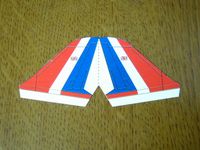 Cut out part #11 as shown in the right picture.
Cut out part #11 as shown in the right picture.
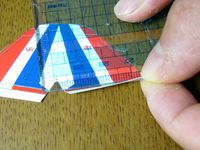 Score all dashed lines and fold two tabs along the scored dashed line.
Score all dashed lines and fold two tabs along the scored dashed line.
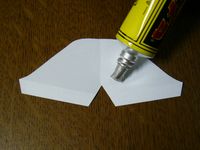 Rotate the part as shown with the printed side down. Coat one side surface with the glue and fold it down onto the other half. Be sure not to get any glue on the tabs attached to the two halves.
Rotate the part as shown with the printed side down. Coat one side surface with the glue and fold it down onto the other half. Be sure not to get any glue on the tabs attached to the two halves.
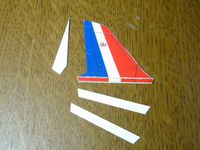 When glue is thoroughly dry, cut out white space as shown in the right picture.
When glue is thoroughly dry, cut out white space as shown in the right picture.
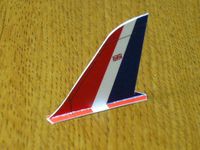 Open out the two tabs so they are flat on the bottom.
Open out the two tabs so they are flat on the bottom.
STEP 4: Canopy
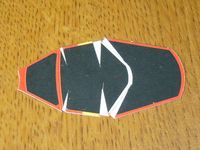 Cut out part #6 as shown in the right picture.
Cut out part #6 as shown in the right picture.
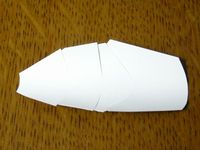 Rotate the part as shown with the printed side down. Curl - do not fold canopy - the front, center and back panels up.
Rotate the part as shown with the printed side down. Curl - do not fold canopy - the front, center and back panels up.
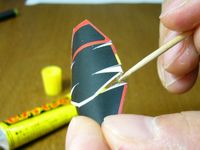 Run a line of glue along the white area of the part. Tooth pick is useful for placing glue on narrow area.
Run a line of glue along the white area of the part. Tooth pick is useful for placing glue on narrow area.
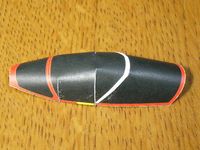 The canopy is completed.
The canopy is completed.
STEP 5: Air-Intake
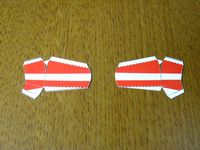 Cut out part #7 and #8 ans score all dashed lines.
Cut out part #7 and #8 ans score all dashed lines.
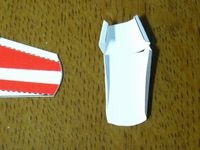 Rotate the part as shown with the printed side down. Curl the front and back panels up and fold along the scored dashed line.
Rotate the part as shown with the printed side down. Curl the front and back panels up and fold along the scored dashed line.
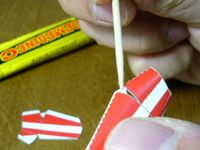 Place glue on a tirangular shaped tab and glue together.
Place glue on a tirangular shaped tab and glue together.
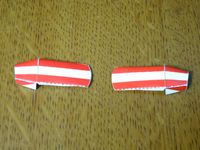 Air-Intakes are completed.
Air-Intakes are completed.
STEP 6: Fusalage
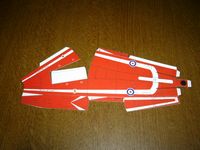 Cut out part #1 as shown in the right picture.
Cut out part #1 as shown in the right picture.
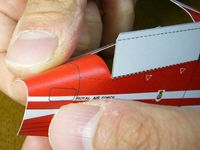 Curl the nose of the part as shown in the right picture.
Curl the nose of the part as shown in the right picture.
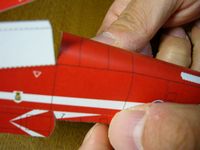 Curl the fuselage of the part as shown in the right picture.
Curl the fuselage of the part as shown in the right picture.
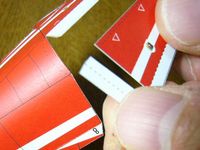 Cut out part #2 and run a line of glue on the half of it. Glue the part to the part #1 as showin in the right picture.
Cut out part #2 and run a line of glue on the half of it. Glue the part to the part #1 as showin in the right picture.
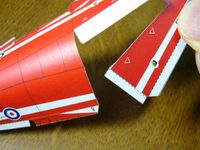 The right picture shows that one half of the part #2 is attached to the part #1.
The right picture shows that one half of the part #2 is attached to the part #1.
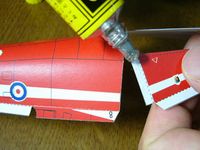 Run a line of glue on the another half of the part #2.
Run a line of glue on the another half of the part #2.
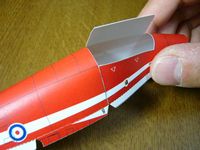 Glue the part to the part #1 to #2 as showin in the right picture.
Glue the part to the part #1 to #2 as showin in the right picture.
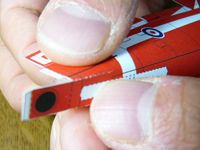 Fold the dashed line printed backward of the fuselage as shown in the right picture.
Fold the dashed line printed backward of the fuselage as shown in the right picture.
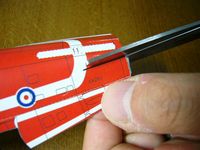 Cut the slits in the back of the fuselage to attache the horizontal stabilizer assembled under the Step 2 mentioned above.
Cut the slits in the back of the fuselage to attache the horizontal stabilizer assembled under the Step 2 mentioned above.
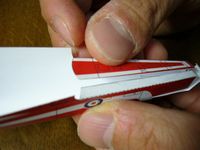 Form the part into a tube that is flat on the bottom. Glue together with a line of glue along the tab.
Form the part into a tube that is flat on the bottom. Glue together with a line of glue along the tab.
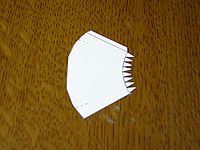 Cut out part #3 as shown in the right picture and score two dashed lines.
Cut out part #3 as shown in the right picture and score two dashed lines.
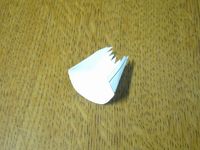 Fold the scored dashed lines and form the part into a tube and glue together with a line of glue along the tab.
Fold the scored dashed lines and form the part into a tube and glue together with a line of glue along the tab.
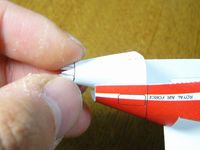 Coat surface of the part #3 with glue and attach it inside the nose of the fuselage (part #1).
Coat surface of the part #3 with glue and attach it inside the nose of the fuselage (part #1).
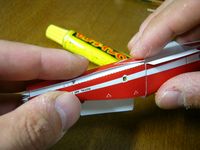 Glue together with a line of glue along the tab.
Glue together with a line of glue along the tab.
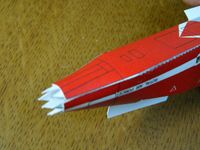 Nose should be a tube - not flat tube - as shown in the right picture.
Nose should be a tube - not flat tube - as shown in the right picture.
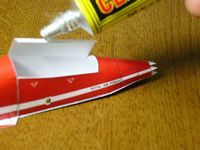 Run a line of glue along the tab as shown in the right picture.
Run a line of glue along the tab as shown in the right picture.
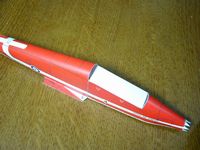 Glue together with a line of glue along the tab.
Glue together with a line of glue along the tab.
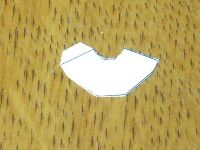 Cut out part #4 and rotate it as shown with the printed side down.
Cut out part #4 and rotate it as shown with the printed side down.
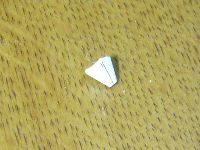 Form the part into a cone and glue together with a line of glue along the tab.
Form the part into a cone and glue together with a line of glue along the tab.
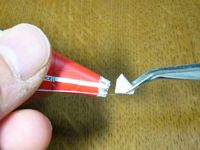 Attach the nose to the fuselage with a line of glue along the triangular shaped tabs.
Attach the nose to the fuselage with a line of glue along the triangular shaped tabs.
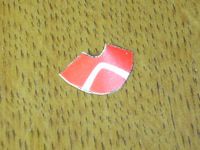 Cut out part #5 and form the part into a cone.
Cut out part #5 and form the part into a cone.
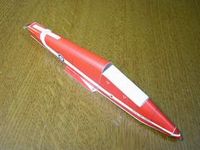 Glue the part #5 to the nose as shown in the right picture. The fuselage is complete.
Glue the part #5 to the nose as shown in the right picture. The fuselage is complete.
STEP 7: Final Assembly
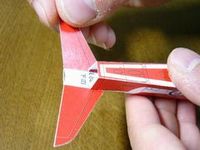 Slide the horizontal stabilizer and the fuselage together.
Slide the horizontal stabilizer and the fuselage together.
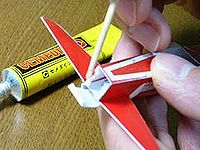 Put glue on the tabs and glue together.
Put glue on the tabs and glue together.
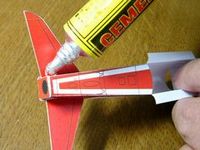 To fix the horizontal stabilizer, run a line of glue along the fuselage.
To fix the horizontal stabilizer, run a line of glue along the fuselage.
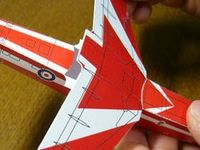 Glue the wing to the fuselage on the area indicated on the printouts.
Glue the wing to the fuselage on the area indicated on the printouts.
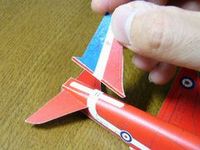 Glue the vertical stabilizer to the fuselage in the area indicated on the printouts.
Glue the vertical stabilizer to the fuselage in the area indicated on the printouts.
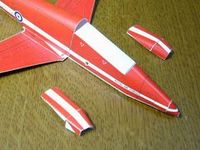 Glue the air-intakes to the fuselage in the area indicated on the printouts.
Glue the air-intakes to the fuselage in the area indicated on the printouts.
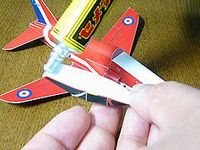 Run a line of glue around the inside of the canopy. Glue the canopy to the fuselage in the area indicated on the printouts.
Run a line of glue around the inside of the canopy. Glue the canopy to the fuselage in the area indicated on the printouts.
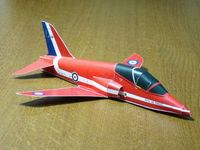 Your Red Arrows' Hawk T.1 is now complete!
Your Red Arrows' Hawk T.1 is now complete!
PR: q湩]ÔWeb-¿iâ@\Åär- |
d®AVXg©]ÔWeb-¿iâ@\Åär- |
©]ÔÛ¯ |
Ü载ݩ]ÔX[oCNWeb-¿iâ@\Åär- |
VÌ]¾Web-VÌ]¾ÌIÑû |
MTB }EeoCNärWeb
 To build flying models, it is recommended to use index or card weight paper (approximately 100 - 130 kg), which is much heavier than the normal paper you usually print with. When you use heavier paper, the planes will be more rigid and the wings will not flop around as much. Be careful before feeding heavy paper through your printer. Some printers do not support the use of heaby card stock paper. You'll want to check your printer manual before purchasing this type of paper.
To build flying models, it is recommended to use index or card weight paper (approximately 100 - 130 kg), which is much heavier than the normal paper you usually print with. When you use heavier paper, the planes will be more rigid and the wings will not flop around as much. Be careful before feeding heavy paper through your printer. Some printers do not support the use of heaby card stock paper. You'll want to check your printer manual before purchasing this type of paper.
 Remember to score all dashed lines before beginning to cut and assemble your model.
Remember to score all dashed lines before beginning to cut and assemble your model.
 Cut out part #10 and rotate it as shown with the printed side down.
Cut out part #10 and rotate it as shown with the printed side down.
 Coat one side surface with the glue. Place the wing on a flat surface, fold down and smooth out glue. Weight down so that the glued wing dires flat.
Coat one side surface with the glue. Place the wing on a flat surface, fold down and smooth out glue. Weight down so that the glued wing dires flat.
 When glue is thoroughly dry, score all dashed lines.
When glue is thoroughly dry, score all dashed lines.
 Bend up along the scored dashed line for dihedral.
Bend up along the scored dashed line for dihedral.
 Cut out part #9 as shown in the right picture.
Cut out part #9 as shown in the right picture.
 Rotate the part as shown with the printed side down and coat one side surface with the glue.
Rotate the part as shown with the printed side down and coat one side surface with the glue.
 Place the wing on a flat surface, fold down and smooth out glue. Weight down so that the glued horizontal stabilizer dires flat.
Place the wing on a flat surface, fold down and smooth out glue. Weight down so that the glued horizontal stabilizer dires flat.
 When glue is thoroughly dry, cut out white space as shown in the right picture.
When glue is thoroughly dry, cut out white space as shown in the right picture.
 Score all dashed lines and bend up along the scored dashed line for anhedral.
Score all dashed lines and bend up along the scored dashed line for anhedral.
 Cut out part #11 as shown in the right picture.
Cut out part #11 as shown in the right picture.
 Score all dashed lines and fold two tabs along the scored dashed line.
Score all dashed lines and fold two tabs along the scored dashed line.
 Rotate the part as shown with the printed side down. Coat one side surface with the glue and fold it down onto the other half. Be sure not to get any glue on the tabs attached to the two halves.
Rotate the part as shown with the printed side down. Coat one side surface with the glue and fold it down onto the other half. Be sure not to get any glue on the tabs attached to the two halves.
 When glue is thoroughly dry, cut out white space as shown in the right picture.
When glue is thoroughly dry, cut out white space as shown in the right picture.
 Open out the two tabs so they are flat on the bottom.
Open out the two tabs so they are flat on the bottom.
 Cut out part #6 as shown in the right picture.
Cut out part #6 as shown in the right picture.
 Rotate the part as shown with the printed side down. Curl - do not fold canopy - the front, center and back panels up.
Rotate the part as shown with the printed side down. Curl - do not fold canopy - the front, center and back panels up.
 Run a line of glue along the white area of the part. Tooth pick is useful for placing glue on narrow area.
Run a line of glue along the white area of the part. Tooth pick is useful for placing glue on narrow area.
 The canopy is completed.
The canopy is completed.
 Cut out part #7 and #8 ans score all dashed lines.
Cut out part #7 and #8 ans score all dashed lines.
 Rotate the part as shown with the printed side down. Curl the front and back panels up and fold along the scored dashed line.
Rotate the part as shown with the printed side down. Curl the front and back panels up and fold along the scored dashed line.
 Place glue on a tirangular shaped tab and glue together.
Place glue on a tirangular shaped tab and glue together.
 Air-Intakes are completed.
Air-Intakes are completed.
 Cut out part #1 as shown in the right picture.
Cut out part #1 as shown in the right picture.
 Curl the nose of the part as shown in the right picture.
Curl the nose of the part as shown in the right picture.
 Curl the fuselage of the part as shown in the right picture.
Curl the fuselage of the part as shown in the right picture.
 Cut out part #2 and run a line of glue on the half of it. Glue the part to the part #1 as showin in the right picture.
Cut out part #2 and run a line of glue on the half of it. Glue the part to the part #1 as showin in the right picture.
 The right picture shows that one half of the part #2 is attached to the part #1.
The right picture shows that one half of the part #2 is attached to the part #1.
 Run a line of glue on the another half of the part #2.
Run a line of glue on the another half of the part #2.
 Glue the part to the part #1 to #2 as showin in the right picture.
Glue the part to the part #1 to #2 as showin in the right picture.
 Fold the dashed line printed backward of the fuselage as shown in the right picture.
Fold the dashed line printed backward of the fuselage as shown in the right picture.
 Cut the slits in the back of the fuselage to attache the horizontal stabilizer assembled under the Step 2 mentioned above.
Cut the slits in the back of the fuselage to attache the horizontal stabilizer assembled under the Step 2 mentioned above.
 Form the part into a tube that is flat on the bottom. Glue together with a line of glue along the tab.
Form the part into a tube that is flat on the bottom. Glue together with a line of glue along the tab.
 Cut out part #3 as shown in the right picture and score two dashed lines.
Cut out part #3 as shown in the right picture and score two dashed lines.
 Fold the scored dashed lines and form the part into a tube and glue together with a line of glue along the tab.
Fold the scored dashed lines and form the part into a tube and glue together with a line of glue along the tab.
 Coat surface of the part #3 with glue and attach it inside the nose of the fuselage (part #1).
Coat surface of the part #3 with glue and attach it inside the nose of the fuselage (part #1).
 Glue together with a line of glue along the tab.
Glue together with a line of glue along the tab.
 Nose should be a tube - not flat tube - as shown in the right picture.
Nose should be a tube - not flat tube - as shown in the right picture.
 Run a line of glue along the tab as shown in the right picture.
Run a line of glue along the tab as shown in the right picture.
 Glue together with a line of glue along the tab.
Glue together with a line of glue along the tab.
 Cut out part #4 and rotate it as shown with the printed side down.
Cut out part #4 and rotate it as shown with the printed side down.
 Form the part into a cone and glue together with a line of glue along the tab.
Form the part into a cone and glue together with a line of glue along the tab.
 Attach the nose to the fuselage with a line of glue along the triangular shaped tabs.
Attach the nose to the fuselage with a line of glue along the triangular shaped tabs.
 Cut out part #5 and form the part into a cone.
Cut out part #5 and form the part into a cone.
 Glue the part #5 to the nose as shown in the right picture. The fuselage is complete.
Glue the part #5 to the nose as shown in the right picture. The fuselage is complete.
 Slide the horizontal stabilizer and the fuselage together.
Slide the horizontal stabilizer and the fuselage together.
 Put glue on the tabs and glue together.
Put glue on the tabs and glue together.
 To fix the horizontal stabilizer, run a line of glue along the fuselage.
To fix the horizontal stabilizer, run a line of glue along the fuselage.
 Glue the wing to the fuselage on the area indicated on the printouts.
Glue the wing to the fuselage on the area indicated on the printouts.
 Glue the vertical stabilizer to the fuselage in the area indicated on the printouts.
Glue the vertical stabilizer to the fuselage in the area indicated on the printouts.
 Glue the air-intakes to the fuselage in the area indicated on the printouts.
Glue the air-intakes to the fuselage in the area indicated on the printouts.
 Run a line of glue around the inside of the canopy. Glue the canopy to the fuselage in the area indicated on the printouts.
Run a line of glue around the inside of the canopy. Glue the canopy to the fuselage in the area indicated on the printouts.
 Your Red Arrows' Hawk T.1 is now complete!
Your Red Arrows' Hawk T.1 is now complete!